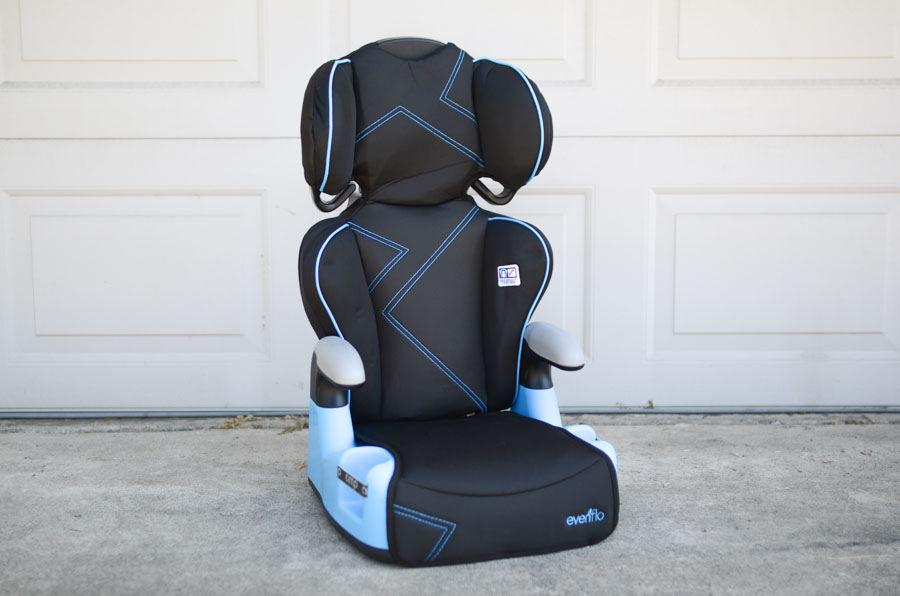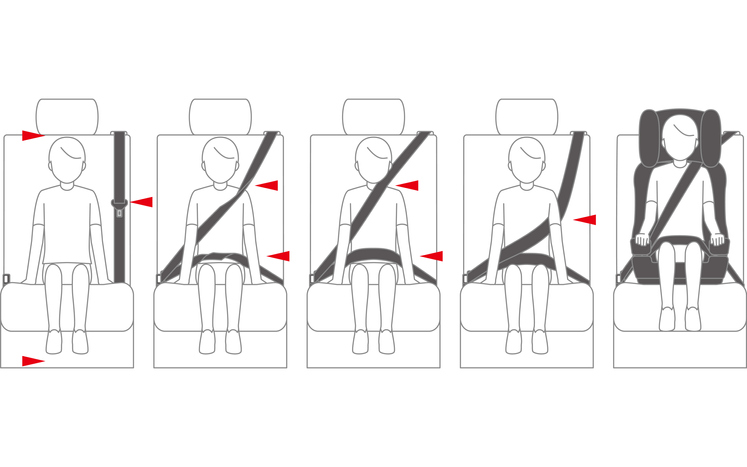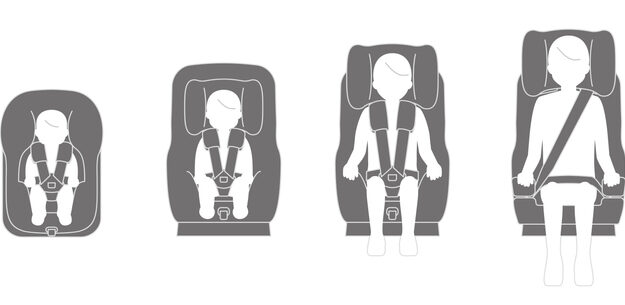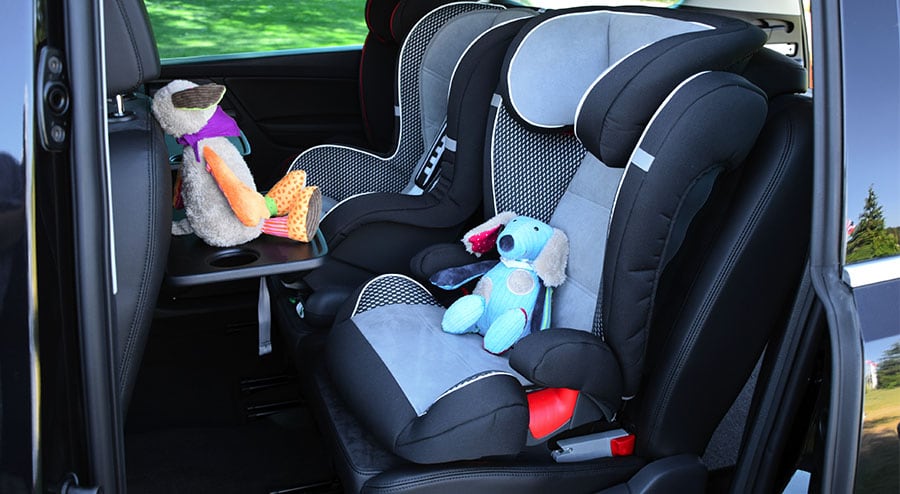When it comes to the safety of your young child, there are many things that you need to consider. This not only includes safety in the home or while they are at school but also when they are traveling in the car with you. As parents, you will find that you often have to drive with your young child whether it is to take them to the nursery, go on a play date, to visit relations, to go on vacation, or to get to the doctor among other things. When your child is traveling in the vehicle with you, it is important that they are safe, secure, and comfortable. In the event of an accident, you need to ensure that the risk of injury to your little one is minimized and this is where child car safety seats come into the equation.

Table of Contents
- At What Age Does a Child Go from a Car Seat to a Booster Seat?
- Can a 4-year-old Be in a Regular Booster Seat?
- What Kind of Booster Seat Do You Need For a 7-year-old?
- At What Age Should a Child Stop Using a Car Seat?
- Making Sure You Are Familiar With The Regulations By State
- The Regulations In Different States
- Checking The Regulations In Your State
There are various different types of seat available to ensure child passenger safety, which includes rear-facing car seats, forward-facing car seats, and belt-positioning booster seats. The first two options are for young babies that are under a certain weight and age. However, once your child goes beyond a specified weight and age you can switch to the child booster seat. These seats are designed to provide safety and comfort to your little one when traveling in the car, as they will be too small to use a regular seatbelt or shoulder belt to reduce the risk of injury in the event of an accident.
At What Age Does a Child Go from a Car Seat to a Booster Seat?
The transition from a car seat to a booster seat is a significant milestone in a child’s life, and it is one that parents often approach with a mix of excitement and apprehension. After all, the safety of one’s child is paramount, and the selection of appropriate car safety equipment plays a crucial role in ensuring that safety. The age at which a child moves from a car seat to a booster seat doesn’t depend solely on age; it’s a combination of age, weight, height, and maturity.
Initially, it’s important to understand the two distinct phases of car seats before the transition to a booster seat. The first phase is the rear-facing infant or convertible seat, which is the safest position for babies and toddlers. Most safety experts, including the American Academy of Pediatrics (AAP), advise parents to keep their children in rear-facing seats until they reach the seat’s weight or height limits, typically around 2 years of age or even longer. Once a child outgrows the rear-facing limits, they transition to a forward-facing car seat with a harness.
Around age 3 to 6 years is a good gauge, but the decision should be also based on height, weight, and maturity. Place the child in a forward-facing car seat using the strap. Once a child has outgrown their seat and harness, the baby can move into a booster seat in its back seat.here
The second phase, the forward-facing car seat, is where age becomes a more significant factor. While it’s tempting to associate age directly with the transition to a booster, the key indicators are still the child’s size and the seat’s height and weight limitations. On average, many children make the switch from a forward-facing car seat to a booster seat between ages 4 and 7. However, the AAP and other safety organizations advocate for children to remain in a forward-facing car seat until they outgrow its maximum weight or height limits. Some forward-facing car seats have limits that can accommodate kids up to 65 pounds or more.
Maturity is also an essential consideration during this transition. Even if a child reaches the height or weight requirement for a booster seat, if they can’t sit still and properly without the constraints of a 5-point harness, it might be premature to move them to a booster. In a booster seat, the child must sit upright with the seat belt positioned correctly across their body, without excessive fidgeting or repositioning.
While age provides a general guideline, the transition from a car seat to a booster seat is primarily based on weight, height, and maturity. Parents and caregivers should be diligent in reviewing their car seat’s guidelines and, when in doubt, consult with experts or local safety checks to ensure they’re making the best decision for their child’s safety.
Can a 4-year-old Be in a Regular Booster Seat?
When it comes to car safety for children, the decisions parents make are critical in ensuring their child’s well-being. Booster seats play a crucial role in this process. The primary purpose of a booster seat is to elevate a child so that the vehicle’s lap and shoulder belts fit properly, thus providing optimal protection in the event of a crash. The question of whether a 4-year-old can be in a regular booster seat depends on several factors, including the child’s size, weight, and maturity, as well as the specific guidelines of the relevant safety regulations.
Firstly, according to many safety experts and organizations, including the American Academy of Pediatrics (AAP), children should remain in a forward-facing car seat with a harness for as long as possible, until they outgrow the maximum weight or height limits set by the seat’s manufacturer. This is primarily because the 5-point harness in a forward-facing car seat provides a higher level of protection compared to a seatbelt in a regular booster seat. The average 4-year-old might not have reached this threshold yet.
Secondly, if considering transitioning a child to a booster seat, the child’s weight is a key determining factor. While there are booster seats in the market that accommodate children starting from 30 pounds, it’s worth noting that many safety experts recommend waiting until a child is at least 40 pounds before making the transition. This ensures that the child is heavy enough for the seat belt to effectively restrain them in the case of a collision.
Lastly, maturity plays a significant role in determining the readiness of a 4-year-old for a booster seat. The reason is, that children in booster seats must be mature enough to sit still without slouching, leaning over, or playing with the seat belt. If a child isn’t mature enough to sit properly, the seat belt won’t fit right and won’t provide adequate protection in a crash. This is a subjective measure and varies from child to child. Parents need to honestly assess whether their 4-year-old can handle the responsibility.

While some 4-year-olds might technically fit into a regular booster seat based on their weight, the current safety standards recommend erring on the side of caution. It’s best to keep a child in a forward-facing seat with a harness for as long as possible before transitioning to a booster. When considering the switch, weight, size, and maturity should all factor into the decision-making process. Safety should always be the top priority.
What Kind of Booster Seat Do You Need For a 7-year-old?
As children grow and develop, their car safety needs evolve. When considering booster seats for 7-year-olds, it’s crucial to match the seat to the child’s specific requirements, considering factors like size, weight, and maturity. A booster seat’s primary purpose is to ensure that the vehicle’s regular seat belt fits a child correctly, protecting the most vulnerable areas during a collision, which are the chest, belly, and neck. There are two main types of booster seats: high-back boosters and backless boosters, and determining which one is appropriate for a 7-year-old involves several considerations.
High-back booster seats are typically recommended for younger children just transitioning out of forward-facing car seats or for vehicles without headrests or with low seat backs. These booster seats provide additional head and neck support and can help guide the shoulder strap of the seat belt to fit securely across the child’s chest and shoulder. Additionally, they can offer side-impact protection which might be advantageous for children who still tend to lean or fall asleep in the car, ensuring that their head is supported.
Backless booster seats, on the other hand, are more minimalist. They simply elevate the child so that the lap and shoulder belts fit correctly. They are usually deemed suitable for older children who have outgrown the high-back booster and can sit properly in the seat without additional support. They’re more portable and often preferred by older kids since they look less like a “baby seat.”
Combination seat: The combination seat has an upper back booster seat that has five points that are also known as combination seats. The five-point harness is suitable to use on children weighing up to 40kg. The seat becomes an adjustable strap and is connected with the seat belt and belt.
When determining the kind of booster seat for a 7-year-old, a few key factors come into play:
- Vehicle’s design: If the car has low seat backs or lacks headrests, a high-back booster would provide additional head and neck support.
- Child’s size and behavior: If the child is on the smaller side for their age or tends to move around, lean, or sleep during drives, the side supports and the more defined belt paths of a high-back booster might be more appropriate.
- Ride duration: For longer rides, the added support and comfort of a high-back might be beneficial.
While many 7-year-olds can safely and comfortably use a backless booster seat, it’s important to evaluate the individual needs of the child and the specifics of the vehicle. The ultimate goal is to ensure that the seat belt fits the child correctly and provides the best protection possible. As always, parents should also refer to the manufacturer’s guidelines for any booster seat they’re considering and might want to consult with local car seat inspection stations or safety experts for additional guidance.

At What Age Should a Child Stop Using a Car Seat?
The transition from a car seat to a booster seat and eventually to using only a vehicle’s seat belt is a vital progression in a child’s journey to becoming independent. Ensuring that each phase is timed correctly is crucial for the child’s safety. Generally, the progression is not just age-based but takes into consideration the child’s height, weight, and maturity level. As to the question of when a child should stop using a car seat altogether and transition to just the vehicle’s seat belt, multiple factors come into play.
It’s important to note that booster seats themselves are a transitional tool designed to position children so that a regular seat belt fits them correctly. The ultimate goal is to ensure that when a child is using only the vehicle’s seat belt, it fits in such a way that the lap belt lies snugly across the upper thighs, not the stomach, and the shoulder belt lies snug across the shoulder and chest, not the neck or face.
As of 2019, in the state of California, children under the age of 8 must be secured in a car seat or booster seat in the back seat. Children who are 8 years of age OR have reached 4’9” in height may be secured by a booster seat, but at a minimum must be secured by a safety belt. (California Vehicle Code Section 27360.)
Typically, children transition from booster seats to seat belts alone between the ages of 8 to 12 years old. However, age should not be the sole determinant. The National Highway Traffic Safety Administration (NHTSA) recommends a simple “Seat Belt Fit Test” to see if the child is ready to move on from the booster:
- Seat Position: The child should sit all the way back against the vehicle seat.
- Lap Belt Placement: The seat belt should lie snugly across the child’s upper thighs, not the stomach.
- Shoulder Belt Placement: The belt should fit snugly across the shoulder and chest, away from the face and neck.
- Knees and Legs: The child’s knees should bend naturally at the edge of the vehicle seat, and their feet should be flat on the floor.
If all these criteria are met without the assistance of a booster seat, then the child can typically use the seat belt alone. If not, the child should continue using the booster seat for their safety. Moreover, the child should be tall enough—typically at least 4 feet 9 inches—to use the car’s seat belt system without a booster.
There are general age brackets that serve as guidelines for car seat transitions, the key is to focus on the child’s individual size and how the seat belt fits them. Parents and guardians should always prioritize a child’s safety and well-being and consider seeking expert advice or consultations from local safety checks to ensure they’re making the most informed decision. Remember, the primary objective is to ensure that the child is as safe as possible during every car journey.
Making Sure You Are Familiar With The Regulations By State
The regulations with regard to child booster seats can vary from one state to another. As a result, you need to ensure that you are familiar with the regulations in your state. You can do this by going online to check what the requirements are for your specific state. Also, bear in mind that these regulations are often updated so if you last looked at them several years ago for another child it is worth checking again in case there are any changes. You will then have a better idea of what to look for when you are purchasing a child booster seat for your little one.
In many states, the laws, with regard to child booster seats, can appear quite vague but they have specific meanings. For example, in some states, the laws state that the child must be in a seat that is ‘appropriate,’ which means that it must be a seat that is used by a child of the size, weight, height, and age as per the label on the seat. This means that it is essential to ensure you read the labeling on these car seats so that you know whether it is a seat that will be suitable for your child and will, therefore, be in adherence to the legal requirements. Some states also have laws that say the seat must be properly installed. However, this can mean different things in different states. In some states, this means that the manufacturer’s instructions are used to verify that the seat has been properly installed in the vehicle.
The Regulations In Different States
Regulations regarding booster seats vary from state to state. In Louisiana, for instance, children aged between four and six and who weigh between 40 and 60 pounds have to be in a booster car seat with a belt-positioning feature. In the event that a child is of an age, weight, and height to fall into two child seat categories, the safest option must be decided upon by the parents. In Alaska, however, you have to use a booster seat for children aged between four and eight who weigh up to 65 pounds and are up to 4’9” in height. So, let’s take a look at the booster seat regulations state by state:
- Alabama: In Alabama, children must be in forward-facing seats until the age of five or when they reach 40 pounds. They must be in booster seats until the age of six.
- Alaska: In this state, children must ride in a booster seat between the ages of four and eight other than if they weigh more than 65 pounds and are over 4’9” tall.
- Arizona: Arizona requires children to be in a booster seat from the age of five until eight unless they are taller than 4’9”.
- Arkansas: In this state, children up to the age of six years and under 60 pounds in weight should be riding in an appropriate child or booster seat.
- Colorado: In this state, children aged between four and eight years of age should be riding in a suitable car or booster seat.
- Delaware: In Delaware, children aged up to seven years and weighing up to 65 pounds need to be restrained in an appropriate child or booster seat designed for their age and size.
- Georgia: Children must ride in an approved car seat until the age of eight. The booster or car seat should be suitable for the child’s age and height and must be fitted and used as per the instructions.
- Hawaii: In this state, children aged between four and seven must right in a booster seat or car seat designed for their age. Tax credits are available to put toward the cost of buying a suitable seat.
- Indiana: Indiana requires children less than the age of eight years to be in an approved car or booster seat. This must be properly installed and used as per the instructions and must be designed for the child’s age, height, and weight.
- Iowa: Children less than the age of six years must be in an approved car or booster. Those under one year and weighing less than 20 pounds have to be in a rear-facing car seat.
- Louisiana: In this state, children who are aged between four and six years and weigh between 40 and 60 pounds must be in a car booster seat.
- Maine: In Maine, children aged eight or under and who weigh under 80 pounds must be in an approved car seat or booster.
- Massachusetts: Under laws in this state, all children under the age of eight and who are less than 57 inches in height must be in an approved car or booster seat that is suitable for their size and weight.
- Michigan: According to Michigan laws, all children aged between four and eight years need to be in a properly restrained booster or car seat.
- Minnesota: Under laws in this state, all children aged seven and under who are under 4’9” need to be in an approved car seat or booster. Installation and use of the seat must be as per the manufacturer’s instructions.
- Mississippi: Under these laws, children aged under four must be in a car seat. From four to seven years of age, they must be in a seat that is suited to their age and weight.
- Missouri: In this state, children who are aged between four and seven years, are between 40 and 80 pounds, and are less than 4’9” in height must be in a child/booster seat.
- Nebraska: All children under the age of six must ride in an appropriate and approved car or booster seat in this state. The seat must be suited to their age and size.
- Nevada: In Nevada, all children aged less than six years and weighing up to 60 pounds must ride in a suitable and approved car or booster seat based on their age and size.
- New Mexico: In this state, all children under the age of seven or weighing less than 60 pounds must be in an approved and suitable car or booster seat. Between seven and twelve years, they must be in a seat belt or booster seat designed for their weight and height.
- New York: In New York, children aged up to eight years have to ride in a suitable car or booster seat. The state also recommends that they stay in a booster seat until they are 100 pounds in weight or 4’9” in height, although this is not mandatory.
- North Carolina: In this state, all children who weigh less than 80 pounds or are under eight years of age need to be in a booster seat or appropriate car seat.
- Ohio: Children under the age of four and under 40 pounds in weight need to be riding in a suitable car seat or booster seat in Ohio.
- Oregon: In this state, all children must ride in a suitable and approved car seat or booster seat until they reach 40 pounds in weight.
- Pennsylvania: All children under the age of four must ride in an approved car or booster seat that is suitable for their age and size.
- Rhode Island: In Rhode Island, all children aged under eight and who weigh less than 80 pounds have to be in a car or booster seat that is appropriate for their age.
- South Dakota: In this state, all children aged under five and less than 40 pounds in weight will need to be in a suitable car seat or booster seat.
- Tennessee: The regulations in this state require children aged between four and eight years to use a booster seat if they are not at least 4’9” in height.
- Texas: In Texas, the law is that all children up to the age of eight must be in a suitable car or booster seat if they are less than 4’9” tall.
- Washington: In Washington, all children who are less than eight years of age must be in a suitable booster or car seat based on their age and size unless they are at least 4’9” tall.
- West Virginia: All children in this state must ride in an approved booster or car seat until the age of eight years and up to 4’9” in height.
Checking The Regulations In Your State
In order to ensure you adhere to the laws in the different states, you should make sure that you are familiar with car and booster seat regulations if you travel with children. Failure to do this can lead to both financial and other penalties. In addition, and more importantly, it could put the child’s safety at risk.




